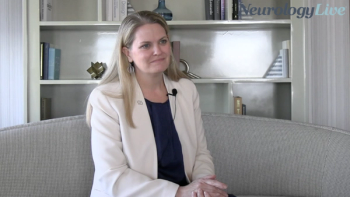
Cefaly External Trigeminal Neurostimulation Device Shows Positive Signs in Chronic Migraine
Both the frequency of headache days and the intake of acute medication were decreased with the use of a daily, single 20-minute eTNS session over the course of 3 months in an open-label, monocenter, prospective pilot trial.
Marius Birlea, MD
External trigeminal neurostimulation (eTNS) with the Cefaly device has been shown to be both safe and effective as a prophylactic treatment for patients with chronic migraine in an open-label, monocenter, prospective pilot trial.
All told, both the frequency of headache days and the intake of acute medication were decreased with the use of a daily, single 20-minute eTNS session over the course of 3 months. Led by Marius Birlea, MD, assistant professor, neurology, and director, Headache Fellowship, University of Colorado School of Medicine, the investigators concluded that based on these findings, a randomized and sham-controlled trial would be sensible.
“Taken together, the outcomes in our pilot trial appear markedly better than the placebo response reported in two noninvasive neurostimulation studies,” Birlea and colleagues wrote. “However, the difference in the trial protocol (open-label vs. placebo-controlled) limits this comparison. Nevertheless, the outcomes of our study strongly suggest that eTNS is effective for the preventive treatment of [chronic migraine].”
In total, 58 patients at the University of Colorado, Anschutz Medical Campus were included in the study. Of those, 58.6% (n = 34) had noncontinuous headache, while 41.4% (n = 24) suffered from continuous headache. Continuous headache was defined as meeting the criteria for chronic migraine and being uninterrupted by pain-freedom for >3 hours, ≥5 days per month. Additionally, 59.6% (n = 33) of patients fulfilled the criteria for medication overuse headache.
The monthly frequency of headache days was reduced by 16.21%, from 22.55 days to 19.43 days (P <.001) in the overall cohort. For those with noncontinuous headache, the frequency of headache days was reduced by 24.38% (P <.001) while those with continuous headache reported a decrease of 4.62%.
As for the mean use of monthly acute medication, the total cohort saw a significant reduction of 30.81%, from 26.33 to 18.22 days (P <.001). In the subgroup with continuous headache, this reduction was more significant (11.85%) than the subgroup with noncontinuous headache (5.47%), although the baseline use of acute medication was higher at baseline, at 32.92 ±41.08, for the continuous headache group compared to the noncontinuous group, at 21.68 ±18.71.
Corresponding author Jean Schoenen, MD, professor, Headache Research Unit, University of Liège, and department of neurology, Citadelle Hospital, told NeurologyLive® that the study was prompted by "the fact the Cefaly is effective for prevention of migraine, even more so in patients with high-frequency migraine and that there is great need for better and more tolerable treatments for chronic migraine." She added that she found it surprising "that Cefaly had an effect size close to that of Botox or topiramate, and there was no quasi-effect in patients with continuous headache."
Ultimately, 44.12% (n = 15) of the noncontinuous group had reverted to an episodic migraine pattern by the end of the 3-month treatment period, with an average of 7.5 headache days posttreatment compared to their 17.2 headache days pretreatment. Save for a single patient whose individual headache days dropped from 16 to 13, every patient in this group had a reduction of at least 5 headache days.
“It would have been interesting to search for a correlation between the frequency of daily sessions and outcomes,” Birlea and colleagues wrote. “Unfortunately, this was not possible in our study because the device recorded the total number of treatment sessions and the total time of use over the 3-month treatment period, but not the number of treatment sessions per day.”
The investigators suggested that future studies utilize a 2-arm trial protocol—a once-daily arm and twice-daily arm—to determine if such a correlation exists. In this trial, the entire cohort averaged 139.32 sessions, equating to slightly more than 1 session per day, while the continuous group averaged slightly more (153.78) total sessions than the noncontinuous group (127.74).
In the 33 patients with medication overuse headache, headache days were reduced by 15.82%, compared to 16.21% in the whole cohort. Likewise, headache episodes, moderate/severe headache days, and migraine days were reduced by a respective 15.42%, 26.67%, and 21.15%. The treatment significantly reduced acute medication intake in the overuse group from 41.52 to 28.45 per month (P < 0.001). At the end of the third month, the number of patients in the group with noncontinuous headache overusing acute medication had decreased by 44%, from 18 at baseline to 10.
Birlea et al noted that with regard to secondary end points, the ≥50% responder rate for migraine days in all study subjects was 18.97%, while those with noncontinuous headache had higher rates of response than those with continuous (29.41% compared to 4.17%). The ≥30% responder rate for migraine days was 24.14% for the overall cohort, and 38.24 and 4.17% in noncontinuous and continuous headache, respectively.
“The treatment effect is greatest in patients with noncontinuous headache; it is hardly significant in those with continuous headache. The treatment is also effective in patients with acute medication overuse and allows overall an important reduction in acute antimigraine drug intake,” Birlea and colleagues concluded. “These results indicate that a randomized sham-controlled trial is worthwhile. Such a trial should plan to stratify the results by continuous headache or not, and, if possible, by the number of daily treatment sessions applied.”
In total, 1 serious adverse event (AE) occurred during the trial, worsening of myasthenia gravis and migraine headaches, though it was not considered related to the device. Only 2 AEs were deemed device-related—skin irritation at the electrode site on the forehead and worsening headaches and vertigo, and the latter patient discontinued using the device.
REFERENCE
Birlea B, Penning S, Callahan K, Schoenen. Efficacy and safety of external trigeminal neurostimulation in the prevention of chronic migraine: An open-label trial. Cephalagia. Published online June 18, 2019. doi: 10.1177/2515816319856625.
Newsletter
Keep your finger on the pulse of neurology—subscribe to NeurologyLive for expert interviews, new data, and breakthrough treatment updates.

































